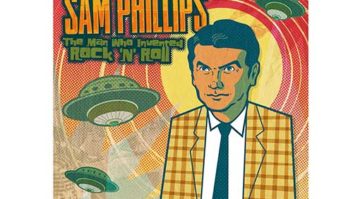MEMPHIS, TN—One of the first images to meet your eye when you crack open Peter Guralnick’s new book is a photograph of a box containing a reel of Scotch magnetic tape. The writing, in part, reads: “Give me ‘hot’ based on both 78+45’s and as much presence peak + bias as possible!”
The man who wrote that message is the subject of the book—Sam Phillips: The Man Who Invented Rock ‘n’ Roll. The recipient? Bill Putnam.

“The one engineer that I heard [Sam] express great admiration for, the first person to whom he ever entrusted a record to master, was Bill Putnam. He met him on a trip to Chicago and was impressed, with the sound at Universal and with Bill Putnam,” says Guralnick, on the phone. As for that note: “Sam wanted to carry everything to the edge of distortion.”
The author, who has written some of the definitive histories of rock ’n’ roll, including a prize-winning, two-volume biography of Elvis Presley (Last Train to Memphis and Careless Love), initially met Knox, Phillips’ eldest son, after publishing Feel Like Going Home, which included a short chapter on Sun Records, in 1971. “We became friends,” he says. “From that time on, it was my hope to interview Sam. I wasn’t thinking about a biography. Sam had no interest; he was always looking forward. It took eight years before we finally set up an interview.”
When Phillips finally opened up, “He was determined to impart his lessons, from the first time I met him. It was thrilling, inspiring. Sam saw himself very much as a teacher,” says Guralnick.
Subsequently, Phillips gave many interviews to many outlets. But it took another eight or nine years for him to acquiesce to being the subject of a documentary film—with the same title as this new book, and also written by Guralnick—that debuted in 2000.
Readers probably need no introduction to Phillips, a radio engineer and on-air presenter who established the Sun Records label and recording studios in Memphis and Nashville, and whose name is indelibly linked to artists such as Howlin’ Wolf, Ike Turner, Jerry Lee Lewis, Johnny Cash, Roy Orbison and Elvis Presley, whose careers he helped launch. In his Author’s Note, Guralnick writes that Phillips—who passed away in 2003—would likely have demurred regarding the book’s subtitle; “discovered” might have been preferable to “invented.” Phillips felt he had a mission, the author writes, “to open up an area of freedom within the artist himself…to recognize that individual’s unique quality and then to find the key to unlock it.”
Guralnick elaborates, “He had the patience to sit and sit and never say a discouraging word, maybe move a microphone around, but to wait for the moment to arrive at which something would happen. Then, to seize on that moment and insist on that moment, even if it was full of musical mistakes.”
He comments, “Sam was an engineer who prided himself most of all on his ears and believed that microphone placement was the key to getting the sound that he wanted out of these extremely talented individuals.” But he favored performance over perfection. “Sam said, ‘That’s what we are at Sun Records, just one big creative mistake.’ It wasn’t that he didn’t hear mistakes. He said no one is ever going to listen to the mistakes; they’re going to hear the fervor of the music.
Having set up his Memphis Recording Service facility in early 1950, Phillips had commercial success fairly quickly. “Rocket 88” by Jackie Brenston (backed by Ike Turner and his band), believed by many to be the first rock ’n’ roll record, was released by Chess and hit the number-one spot in the R&B chart in mid-1951.
“It sold over 100,000 copies, which amazed me. That’s a huge hit in the R&B market. He followed that with Howlin’ Wolf’s ‘How Many More Years,’ which went to something like number five on the R&B charts,” Guralnick reports.
Phillips might be credited with inventing rock ‘n’ roll, but there appears to have been nothing calculated about it. “When he started, he was recording exclusively black music, almost entirely blues music,” says Guralnick. “These were people who had not been given a voice, but he felt that this music had universal appeal.”
The Sun sound is remembered by many for its signature, tape-generated slapback echo, created using a second Ampex machine. But Phillips didn’t apply echo indiscriminately, says Guralnick. There’s no slapback on ‘That’s All Right,’ the first single recorded by Presley, for example.
“But on ‘Blue Moon of Kentucky’—the B side—“it’s slathered all over. I think that’s because he didn’t have as much confidence in ‘Blue Moon’ as he did in ‘That’s All Right.’ He applied it differently to different instruments, and different singers. Sometimes, there might be little more than Jerry Lee Lewis’ piano and drums. The third instrument would be the slapback.”
Guralnick’s new biography, Sam Phillips: The Man Who Invented Rock ‘n’ Roll, 25 years in the making and the author’s first book in a decade, is published November 10 by Little, Brown and Company. To coincide, Yep Roc is releasing a 55-song compilation (2CD/3LP) of Sun Records classics, curated by Guralnick, who has also authored track-by-track notes.
Peter Guralnick
peterguralnick.com







